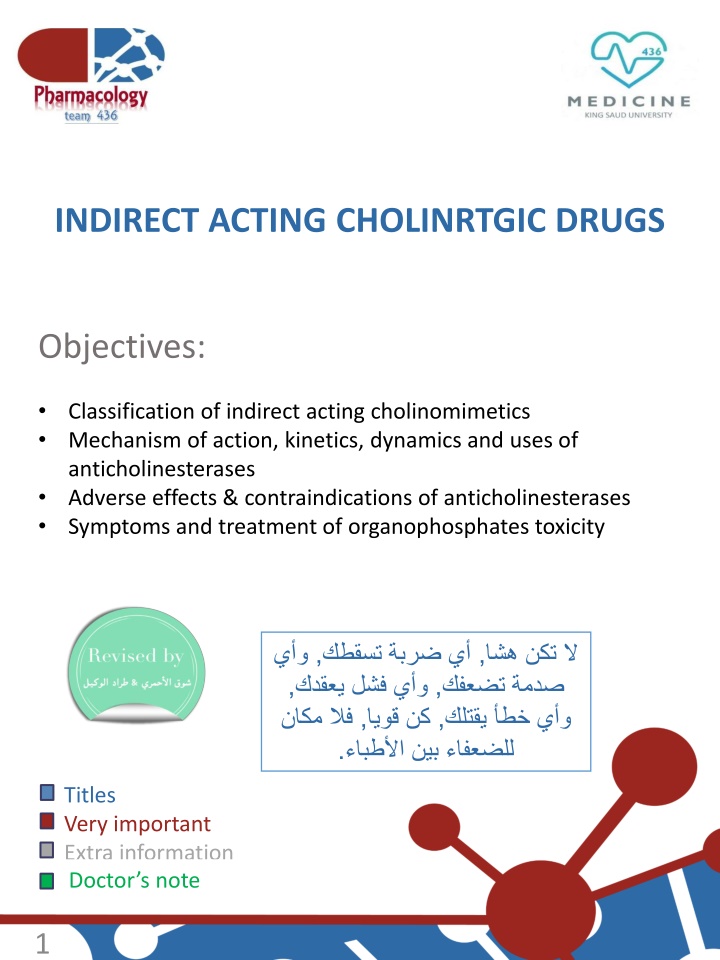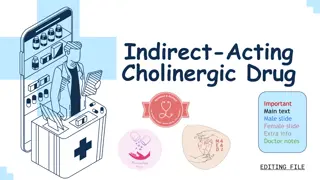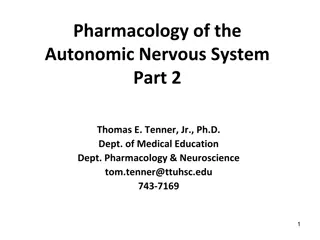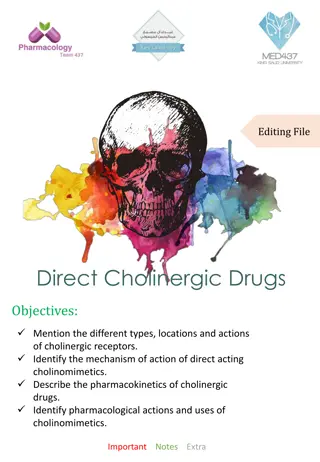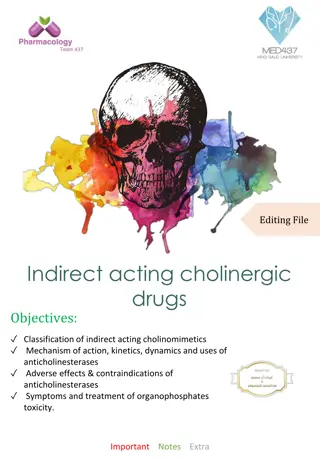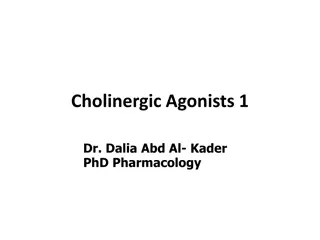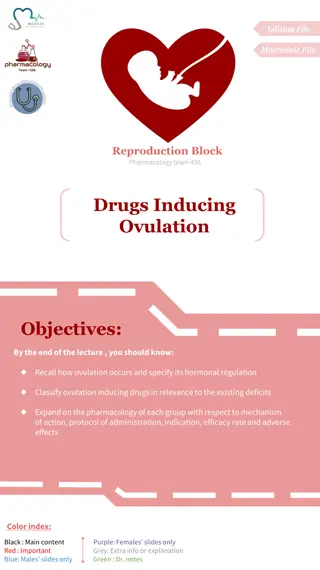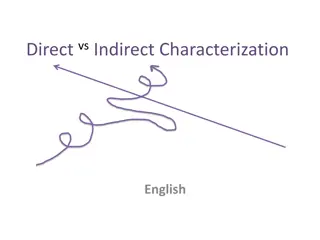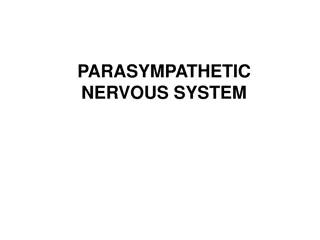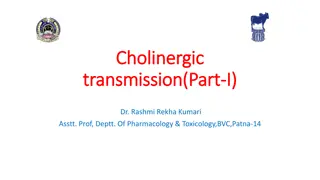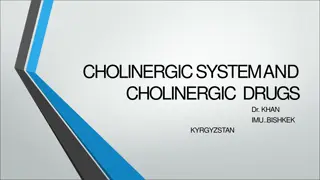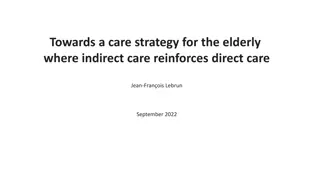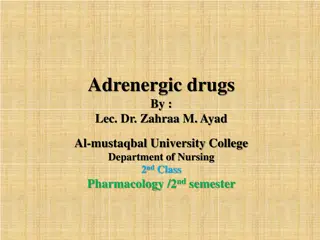Indirect Acting Cholinergic Drugs - Mechanism of Action & Uses
Classification of indirect acting cholinomimetics, mechanism of action, kinetics, dynamics, and uses of anticholinesterases. Understand the adverse effects, contraindications, and treatment of organophosphates toxicity related to indirect acting cholinergic drugs.
Uploaded on Apr 15, 2025 | 0 Views
Download Presentation

Please find below an Image/Link to download the presentation.
The content on the website is provided AS IS for your information and personal use only. It may not be sold, licensed, or shared on other websites without obtaining consent from the author.If you encounter any issues during the download, it is possible that the publisher has removed the file from their server.
You are allowed to download the files provided on this website for personal or commercial use, subject to the condition that they are used lawfully. All files are the property of their respective owners.
The content on the website is provided AS IS for your information and personal use only. It may not be sold, licensed, or shared on other websites without obtaining consent from the author.
E N D
Presentation Transcript
INDIRECT ACTING CHOLINRTGIC DRUGS Objectives: Classification of indirect acting cholinomimetics Mechanism of action, kinetics, dynamics and uses of anticholinesterases Adverse effects & contraindications of anticholinesterases Symptoms and treatment of organophosphates toxicity , , , , , , . Titles Very important Extra information Terms Doctor s note 1
INDIRECT ACTING CHOLINRTGIC DRUGS Also called indirect cholinomimetics: Mechanism of action: Anticholinesterases prevent hydrolysis of Ach by inhibiting acetyl cholinesterase thus, increase Ach concentrations and actions at the cholinergic receptors (both nicotinic and muscarinic). receptors Ach , acetyl cholinesterase Anticholinesterases Ach . As mentioned before Ach act on both nicotinic and muscarinic receptors. Thus, increasing in its concentration will increase its affinity and then produces both nicotinic and muscarinic actions. 2
Structure and function of acetylcholinesterase Normally, acetylcholine binds to acetylcholinesterase at two sites, anionic site and esteric site, then the enzyme somehow breakdown the acetylcholine into acetic acid and choline. In order to inhibit this enzyme we need to create a substance that is similar to acetylcholine either in both sites or even one site. 3
Indirectacting on Ach receptors Reversible anticholinesterases Irreversible anticholinesterases Intermediate acting (Carbamates esters) e.g. Physostigmine, Neostigmine, Pyridostigmine. Long acting Short acting (Alcohols) e.g. edrophonium. Phosphates esters e.g. insecticides, gas war e.g. Ecothiophate & Isoflurophate. Structure: (Reversible anticholinesterases) Short acting: simple alcohols . e.g. Edrophonium Forms weak hydrogen bond with acetylcholinesterase enzyme. Intermediate acting: Carbamic acid esters. e.g. Physostigmine, Pyridostigmine and Neostigmine. binds to two sites of cholinesterase enzyme. All polar and synthetic except physostigmine. 4
Indirectacting on Ach receptors Structure: (Irreversible anticholinesterases): Organic derivatives of phosphoric acid ( Long Acting) e.g. Ecothiophate & Isoflurophate. used as insecticides(malathion) or nerve gases (sarin) . Form very stable covalent bond with cholinesterase . All phosphates are lipid soluble except Ecothiophate which is polar . Edrophonium , .. (thiop) (cno) (E) Pharmacological effects of anticholinesterases: ( All anticholinesterase ) Action Yes/No muscarinic Yes nicotinic Yes Has BBB so CNS effects only lipid soluble drugs CNS actions: (excitation leads to convulsion leads to respiratory failure leads to coma). only for lipid soluble anticholinesterases e.g. physostigmine & phosphate ester 5
Very important to understand not to memorize Pharmacological effects of anticholinesterases Nicotinic actions: Nicotinic actions: Neuromuscular junction: Therapeutic dose leads to muscle contraction while the Toxic dose leads to relaxation or paralysis of skeletal muscles. Ganglia: stimulation of sympathetic and parasympathetic ganglia. Adrenal medulla: release of catecholamines (A & NA). Muscarinic Muscarinicactions : actions : Organs Cholinergic actions Contraction of circular muscle of iris (miosis)(M3) Contraction of ciliary muscles for near vision (M3) Decrease in intraocular pressure eye Heart Bradycardia (decrease heart rate) (M2) Release of nitric oxide (EDRF) endothelium Constriction of bronchial smooth muscles Increase bronchial secretion (M3) Lung Increased motility (peristalsis) Increased secretion Relaxation of sphincter (M3) GIT Urinary bladder Contraction of muscles Relaxation of sphincter (M3) Exocrine glands Increase of sweat, saliva, lacrimal, bronchial, intestinal secretions (M3) EDRF : Endothelium-derived relaxing factor 6
Edrophonium Reversible anticholinesterase. Forms weak hydrogen bond. Alcohol so its Polar. NOT absorbed orally (given by injection). Because its polar so it can t be absorbed easily by oral root. Has short duration of action (5-15 min). Used only for the diagnosis of myasthenia gravis due to its limited duration of action. Edrophonium Eyelid drop (E) (drop) honium myasthenia gravis . Neostigmine Reversible anticholinesterase. Quaternary ammonium comp. Polar compound. Can be used orally. No CNS effect. Has muscarinic & nicotinic actions (prominent on GIT & urinary tract). Uses : Treatment of myasthenia gravis. Paralytic ileus & Urinary retention. Competitive neuromuscular blockers intoxication by increasing the level of Ach. Thus prevent the action of NMBs (Neuromuscular Blocking Agents). 7
Physostigmine Reversible anticholinesterase. Tertiary ammonium compound. Non polar (lipid soluble). Good lipid solubility. Good oral absorption. Has muscarinic, nicotinic action. Cross BBB (has CNS effects). Because it s lipid soluble. Uses : Glaucoma. Atropine toxicity (atropine is anticholinergic drug). used in atropine toxicity because atropine has an effect on the CNS. Thus, we need a drug that can clean up atropine from all over the body. Physostigmine (lipid soluble) ( Atropine toxicity) (Glaucoma) (Physostigmine) Atropine toxicity 8
Chemical structure Drugs Actions Administration Kinetics Uses Myasthenia gravis treatment Paralytic ileus Urinary retention Curare toxicity Quaternary ammonium compound Nicotinic muscarinic M, N Can be used orally -0.5-2hr -polar Neostigmine Good oral absorption, can be used topically in the eye Tertiary ammonium compound Nicotinic muscarinic M, N, CNS -0.5-2hr -nonpolar (lipid soluble ) Glaucoma Atropine toxicity Physostigmine Nicotinic muscarinic M, N Myasthenia gravis treatment -3-6hr -polar Pyridostigmine Quaternary Nicotinic muscarinic M, N -4-8hr -polar Ambenonium Myasthenia gravis treatment Quaternary Quaternary (Attach mainly to acetyl cholinesterase by weak hydrogen bond.) Nicotinic muscarinic M, N Diagnosis of Myasthenia gravis, not for the treatment. injection Edrophonium -5-15 min -Polar 9
Indirect Cholinomimetics Organophosphorous compounds e.g. Ecothiophate Mechanism: -Irreversible anticholinesterase. -Binds to cholinesterase by strong covalent bond. -Have very long duration of action. -Aging make bond extremely stable. -All are highly lipid soluble except ecothiophate. -Used for glaucoma. Symptoms of organophosphates toxicity: Sever bradycardia and hypotension. Lung: Heart: bronchospasm. GIT: CNS: CNS effects (lipid soluble) convulsion, coma and respiratory failure. Increased GIT motility & diarrhea. cramps Skeletal muscles : Initial twitching of skeletal muscles muscle weakness & paralysis. 10
Treatment of organophosphate toxicity Support respiration Cholinesterase reactivator atropine Atropine to block muscarinic action and CNS effect. OXIMES e.g. Pralidoxime (PAM) -cholinesterase reactivator. -Acts by regeneration of cholinesterase enzyme. -reactivates recently inhibited enzymes before aging. -Has poor BBB penetration. Uses -I.V. over 15-30 min for organophosphate intoxication. Pralidoxime used in treatment of organophosphate poisoning due to the ability of regeneration of cholinesterase enzyme Donepezil -it s centrally acting reversible to acetylcholinesterase inhibitor. -Anticholinesterase drugs. -Given orally. -used for treatment of dementia of Alzheimer s disease. 11
Summery of Indirect acting Drugs Reversible anticholinesterases Team 435 Drug Actions Kinetics Pharmacokinetics Uses Alcohols (Short acting) (Weak H-bonds) NOT absorbed orally, given by injection Very Short 5-15min polar Diagnosis of myasthenia gravis Edrophonium M, N Carbamate esters (Intermediate acting) (Bind to two sites) Myasthenia gravis treatment Paralytic ileus Urinary retention Curare toxicity Can be used orally (polar) prominent on GIT & urinary tract. Neostigmine Quaternary ammonium comp Short 0.5-2hr polar M, N Physostigmine Tertiary ammonium compound Short 0.5-2hr non- polar (lipid soluble ) Glaucoma (eye) atropine toxicity Good oral absorption M, N, CNS Myasthenia gravis treatment Short 3-6 polar Pyridostigmine M, N ----- Ambenonium not a stigmine derivative Myasthenia gravis treatment Short 4-8 polar M, N ----- Long acting dementia of Alzheimer s disease Donepezil M, N Long Given orally Irreversible anticholinesterases Drug Actions Kinetics Mechanism Uses Organophosphorus compounds (Long acting) (stable covalent bond) dementia of Alzheimer s disease Isoflurophate M, N, CNS ----- ----- Long 100hr, polar Aging make bond extremely stable Glaucoma M, N Ecothiophate reactivates recently inhibited enzymes before aging pralidoxime (Oximes) organophosphate intoxication M, N, CNS ----- 12
Summary for cholinomimetics & their uses: Eye : treatment of glaucoma - Pilocarpine / - Carbachol (direct muscarinic agonist). - Physostigmine. (indirect cholinomimetics). - Ecothiophate (indirect cholinomimetics). Urinary retention and paralytic ileus -Bethanechol (direct) -Neostigmine (indirect) Myasthenia gravis (only indirect cholinomimetics) -Ambenonium. -Pyridostigmine. (indirect cholinomimetics) -Neostigmine. (indirect cholinomimetics) Myasthenia gravis (Myasthenia gravis) (Pyridostigmine) (Neostigmine) (Ambenonium) . Xerostomia -Pilocarpine -Cevimeline (Used in treatment of Sjogren s syndrome). Sjogren's syndrome : is a long-term autoimmune disease in which the patient's white blood cells attack the saliva and tear glands, leading to dry mouth and eyes. Alzheimer s disease -Donepezil. 13
Adverse effects of cholinergic drugs: Bradycardia Sweating & Salivation Bronchoconstriction Diarrhea (any action other than the main wanted action will be considered as an adverse effect.) Contraindications of cholinergic drugs: Bronchial asthma Peptic ulcer Angina pectoris Incontinence Intestinal obstruction 14
SAQ 32-year-old female came with short history of fatigue associated with ptosis. The patient also noticed that her symptoms increases with work. The doctors expected that she has Myasthenia gravis. 1-What drug can help them in there diagnosis? Edrophonium. 2-Explain the mechanism of action of this drug. The drug binds to acetylcholinesterase by forming a weak hydrogen bond. Thus inhibit the action of acetylcholinesterase which leads to increase amount of Ach which then will release her symptoms. 3-Can we use this drug for treating her disease? This drug can t be used for treating myasthenia gravis due to its extreme short duration of action. 4-list three drugs can be used in this condition? 1-neostigmine. 2-ambenonium. 3-pyridostigmine. 15
SAQ A 56-year-old obese female just got out of a knee joint replacement surgery. Then, she experienced a urinary retention and constipation. The general practitioner prescribed her a drug called Neostigmine. 1-Describe the mechanism of action of this drug. The drug binds to acetylcholinesterase by forming a weak bond between the two binding sites of the enzyme. Thus, increase in Ach which then increases the peristaltic movement of the colon and initiate the movement of the muscle of the urinary bladder. 2-List three possible side effects could be seen in this case. Bronchospasm. Bradycardia. Salivation. 3-Why cholinergic drugs are contraindicated in patient with peptic ulcer? Because cholinergic drugs increases the secretion of gastric acid. 16
QUIZ Boys Girls Contact us : @Pharma436 Pharma436@outlook.com 17
